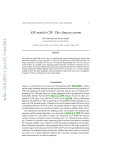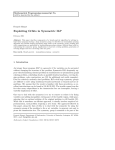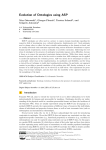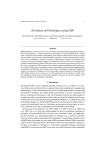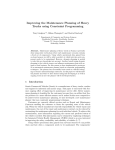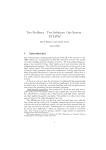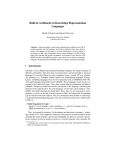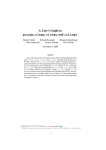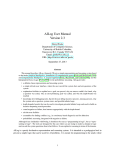Download ASP modulo CSP: The clingcon system
Transcript
ASP modulo CSP: The clingcon system?
Max Ostrowski and Torsten Schaub
Institut für Informatik, Universität Potsdam
Abstract. We present the hybrid ASP solver clingcon, combining the simple
modeling language and the high performance Boolean solving capacities of Answer Set Programming (ASP) with techniques for using non-Boolean constraints
from the area of Constraint Programming (CP). The new clingcon system features an extended syntax supporting global constraints and optimize statements
for constraint variables. The major technical innovation improves the interaction
between ASP and CP solver through elaborated learning techniques based on socalled irreducible inconsistent sets. An empirical evaluation on a broad class of
benchmarks shows that these techniques yield a performance improvement of an
order of magnitude.
1
Introduction
clingcon is a hybrid solver for Answer Set Programming (ASP; [1]), combining the
simple modeling language and the high performance Boolean solving capacities of
ASP with techniques for using non-Boolean constraints from the area of Constraint
Programming (CP). Although clingcon’s solving components follow the approach of
modern Satisfiability Modulo Theories (SMT; [2, Chapter 26]) solvers when combining the ASP solver clasp with the CP solver gecode1 , clingcon adheres to the tradition of
ASP in supporting a corresponding modeling language by appeal to the ASP grounder
gringo. Although in the current implementation the theory solver is instantiated with
the CP solver gecode, the principal design of clingcon along with the corresponding
interfaces are conceived in a generic way, aiming at arbitrary theory solvers.
The underlying formal framework, defining syntax and semantics of constraint
logic programs, the principal algorithms, and first experimental analysis were presented
in [3]. Apart from major re-factoring, clingcon now features an extended syntax supporting global constraints and optimize statements for constraint variables. Also, it allows for more fine-grained configurations of constraint-based lookahead, optimization,
and propagation delays. However, the major technical innovation improves the interaction between ASP and CP solver through elaborated learning techniques. We introduce
filtering methods for conflicts and reasons based on so-called irreducible inconsistent
sets. An empirical evaluation on a broad class of benchmarks shows that these techniques yield a performance improvement of an order of magnitude.
?
1
An extended version of this paper was submitted to ICLP’12.
http://www.gecode.org
2
The clingcon approach
We will briefly explain ASP, a declarative problem solving approach, combining a
rich yet simple modeling language with high-performance solving capacities. A (normal) logic program over an alphabet A is a finite set of rules of the form a0 ←
a1 , . . . , am , not am+1 , . . . , not an , where ai ∈ A is an atom for 0 ≤ i ≤ n.2 A literal is an atom a or its (default) negation not a. For a rule r, let head(r) = a0 be the
head of r and body(r) = {a1 , . . . , am , not am+1 , . . . , not an } be the body of r. Given
a set B of literals, let B + = {a ∈ A | a ∈ B} and B − = {a ∈ A | not a ∈ B}. A set
X ⊆ A is an answer set of a program P over A, if X is the ⊆-smallest model of the
reduct P X = {head(r) ← body(r)+ | r ∈ P, body(r)− ∩ X = ∅}. An answer set can
also be seen as a Boolean assignment satisfying all conditions induced by program P .
The input language of clingcon extends the one of gringo (cf. [4]) by CP-specific
operators marked with a preceding $ symbol, as detailed in Section 4. After grounding, a propositional program is then composed of regular and constraint atoms, denoted
by A and C, respectively. The set of constraint atoms induces an ordinary constraint
satisfaction problem (CSP) (V, D, C), where V is a set of variables with common domain D, and C is a set of constraints. This CSP is to be addressed by the corresponding
CP solver, in our case gecode. As detailed in [3], the semantics of such constraint logic
programs is defined by appeal to a two-step reduction. For this purpose, we consider a
regular Boolean assignment over A ∪ C (an interpretation) and an assignment of V to
D (for interpreting the variables V in the underlying CSP). In the first step, the constraint logic program is reduced to a regular logic program by evaluating its constraint
atoms. To this end, the constraints in C associated with the program’s constraint atoms
C are evaluated wrt the assignment of V to D. In the second step, the common GelfondLifschitz reduct [5] is performed to determine whether the Boolean assignment is an
answer set of the obtained regular logic program. If this is the case, the two assignments
constitute a (hybrid) constraint answer set of the original constraint logic program.
In what follows, we rely upon the following terminology. We use signed literals of
form Ta and Fa to express that an atom a is assigned T or F, respectively. That is,
Ta and Fa stand for the Boolean assignments a 7→ T and a 7→ F, respectively. We
denote the complement of such a literal ` by `. Sometimes we restrict such an assignment A to its constraint atoms by writing A|C . For instance, given the regular atom
‘person(adam)’ and the constraint atom ‘work(adam) $> 4’, we may form the
Boolean assignment {Tperson(adam), Fwork(adam) $> 4}.
We identify constraint atoms in C with constraints in (V, D, C) via a function γ :
C → C. Provided that each constraint c ∈ C has a complement c ∈ C, like ‘ = ’ =
‘ 6= ’ or ‘ < ’ = ‘ ≥ ’, we can extend γ to signed constraint atoms over C:
c if ` = Tc
γ(`) =
c if ` = Fc
For instance, we get γ(Fwork(adam) $> 4) = work(adam) ≤ 4, where
work(adam) ∈ V is a constraint variable and (work(adam) ≤ 4) ∈ C is a constraint. An assignment satisfying the last constraint is {work(adam) 7→ 3}.
2
The semantics of choice rules and integrity constraints is given through program transformations. For instance, {a} ← is a shorthand for a ← not a0 plus a0 ← not a.
Following [6], we represent Boolean constraints issuing from a logic program under ASP semantics in terms of nogoods [7]. This allows us to view inferences in ASP
as unit propagation on nogoods. A nogood is a set {σ1 , . . . , σm } of signed literals, expressing that any assignment containing σ1 , . . . , σm is unintended. A total assignment
A is a solution for a set ∆ of nogoods if δ 6⊆ A for all δ ∈ ∆. Whenever δ ⊆ A, the
nogood δ is said to be conflicting with A. For instance, given atoms a, b, the total assignment {Ta, Fb} is a solution for the set of nogoods containing {Ta, Tb} and {Fa, Fb}.
Likewise, {Fa, Tb} is another solution. Importantly, nogoods provide us with reasons
explaining why entries must (not) belong to a solution, and lookback techniques can be
used to analyze and recombine inherent reasons for conflicts. We refer the interested
reader to [6] for details on how logic programs are translated into nogoods within ASP.
3
The clingcon Architecture
Although clingcon’s solving components follow the approach of modern SMT solvers
when combining the ASP solver clasp with the CP solver gecode, clingcon furthermore
adheres to the tradition of ASP in supporting a corresponding modeling language by
appeal to the ASP grounder gringo. The resulting tripartite architecture is depicted in
Figure 1. Although in the current implementation the theory solver is instantiated with
gringo
clasp
Theory
Language
Theory
Propagator
Theory
Solver
Fig. 1: Architecture of clingcon
the CP solver gecode, the principal design of clingcon along with its interfaces are
conceived in a generic way, aiming at arbitrary theory solvers.
Following the workflow in Figure 1, the first extension concerns the input language of gringo with theory-specific language constructs. Just as with regular atoms, the
grounding capabilities of gringo can be used for dealing with constraint atoms containing first-order variables. The language extensions allow for expressing arithmetic constraints over integer variables. as well as global constraints and optimization statements.
These constraints are treated as atoms and passed to clasp via the standard gringo-clasp
interface, also used in clingo, the monolithic combination of gringo and clasp. Information about these constraints is furthermore directly shared with the theory propagator. In
the new version of clingcon, the theory propagator is implemented as a post propagator,
as furnished by clasp. Theory propagation is done by appeal to the theory solver until
a fixpoint is reached. In doing so, decided constraint atoms are transferred to the theory solver, and conversely constraints whose truth values are determined by the theory
solver are sent back to clasp using a corresponding nogood. Whenever the theory solver
detects a conflict, the theory propagator is in charge of conflict analysis. Apart from reverting the state of the theory solver upon backjumping, this involves the crucial task of
Listing 1.1: Example of a constraint logic program
1
2
3
4
$domain(0..10).
person(adam;smith;lea;john).
1{team(A,B) : person(B) : B != A}1 :- person(A), A == adam.
{friday}.
6
7
8
9
work(A) $+ work(B) $> 6 :- team(A,B).
work(B) $- work(adam) $== 1 :- friday, team(adam,B).
:- team(adam,lea), not work(lea) $== work(adam).
work(B) $== 0 :- person(B), not team(adam,B), B != adam.
11
$count[work(A) $== 8 : person(A)] $== fulltime.
13
$maximize{work(A) : person(A)}.
determining a conflict nogood (which is usually not provided by theory solvers, as in the
case of gecode). This is elaborated upon in Section 5. Similarly, the theory propagator
is in charge of enumerating constraint variable assignments, whenever needed.
4
The clingcon Language
We explain the syntax of our constraint logic programs via the example program in
Listing 1.1. Suppose Adam wants to do a house renovation with the help of three of
his friends. We encode the problem as follows. In Line 1 we restrict all our constraint
variables to the domain [0, 10] as nobody wants to work more than 10 hours a day. In
Line 3 we choose teams. They agreed that each team has to work more than six hours a
day (Line 6). Within this line we show the syntax of linear constraints. They can be used
in the head or body of a rule3 . We use the $ sign in front of every relation and function
symbol referring to the underlying CSP. In this new clingcon version this also applies to
arithmetic operators to better separate them from gringo operators. Many arithmetical
operators are supported, like plus(+), times(∗) and absolute(abs). We use the grounding
capabilities of gringo to create the constraint variables. Grounding Line 6 yields:
work(adam) $+ work(smith) $> 6 :- team(adam,smith).
work(adam) $+ work(lea)
$> 6 :- team(adam,lea).
work(adam) $+ work(john) $> 6 :- team(adam,john).
We created three ground rules containing three different constraints, using four different constraint variables. Note that the constraint variables have not been defined beforehand. All variables occurring in a constraint are automatically constraint variables. On
Fridays, Adam has to pick up his daughter from sports and therefore works one hour
less than his partner (Line 7). Furthermore Lea and Adam are a couple and decided
to have an equal work load if they are in the same team (Line 8). Finally, to prevent
persons from working if they are not in a team we use Line 9.
With this little constraint logic program, we want to show how for example quantities can be easily expressed. Constraints and constraint variables fit naturally into the
logic program. Not representing quantities explicitly with propositional variables eases
the modelling of problems and also decreases the size of the ground logic program.
3
Constraint atoms in the head are shifted to the negative body.
Global Constraints are a new feature of clingcon. They capture relations between a
non-fixed number of variables. As with aggregates in gringo, we can use conditional
literals [8] to represent these sets of variables. In the example we can see a count constraint in Line 11. After grounding this yields:
$count[work(adam) $== 8, work(smith) $== 8,
work(lea) $== 8, work(john) $== 8] $== fulltime.
which constrains the number of variables in {work(adam), work(smith),
work(lea), work(john)} that are equal to 8, to be equal to fulltime. Constraint variable fulltime counts how many persons are working full time. Global
constraints do have a similar syntax to propositional aggregates. Also their semantics is
similar to count aggregates in ASP (cf. [9]). But global constraints only constrain the
values of constraint variables, not propositional ones.
Clingcon supports the global constraint distinct, $distinct{work(A) : person(A)}
means that all persons should have a different workload. That is, all values assigned to constraint variables in {work(adam), work(smith), work(lea),
work(john)} have to be distinct from each other. This constraint could also be expressed using a quadratic number of inequalities. Using a single dedicated constraint is
usually much more efficient in terms of memory consumption and runtime.
As global constraint are usually not supported in a negated form in a CP solver,
we have the syntactic restriction that all global constraints must become facts during
grounding and therefore may only occur in the head of rules. Further global constraints
can easily be integrated into this generic framework.
A valid solution to our constraint logic program in Listing 1.1 contains the regular
literal Tteam(adam,smith), but also constraint literals like Twork(lea)$==0,
Twork(john)$==0 and Twork(adam)$+work(smith)$>6. The solution
also contains the assignment of the constraint variables, like work(adam)7→8,
work(smith)7→3, work(lea)7→0, work(john)7→0 and fulltime7→1.
Optimization is also a new feature of clingcon. In Line 13 we give a maximize statement over constraint variables. We maximize the sum over a set of
variables, in this case work(adam) $+ work(smith) $+ work(lea) $+
work(john). For optimization statements over constraint variables, we also rely
on the syntax of gringo’s propositional optimization statements. We support minimization/maximization and multi-level optimization. To distinguish propositional
and constraint statements, we precede the latter with a $ sign. One optimal solution to the problem contains the propositional literal Tteam(adam,john),
and the constraint literals Twork(lea)$==0, Twork(smith)$==0, and
Twork(adam)$+work(john)$>6. To maximize work load, the constraint
variables are assigned work(adam)7→10, work(smith)7→0, work(lea)7→0,
work(john)7→10 and fulltime7→0.
To find a constraint optimal solution, we have to combine the enumeration techniques of clasp with the ones from the CP solver. Therefore, when we first encounter a
full propositional assignment, we search for an optimal(wrt to the optimize statement)
assignment of the constraint variables using the search engine of the CP solver. We will
explain this given the following constraint logic program.
$domain(1..100).
a :- x $* x $< 25.
$minimize{x}.
Assume clasp has computed the full assignment {Fx $* x $< 5, Fa}. Afterwards,
we search for the constraint optimal solution to the constraint variable x which is {x 7→
5}. Given this optimal assignment, a constraint can be added to the CP solver that all
further solutions shall be below/above this optimum (x$<5). This constraint now will
restrict all further solutions to be “better”. We enumerate further solutions, using the
enumeration techniques of clasp. So the next assignment is {Tx $* x $< 5, Ta}
and the CP solver finds the optimal constraint variable assignment {x 7→ 1}. Each new
solution restricts the set of further solutions, so our constraint is changed to (x$<1)
which will then allow no further solutions to be found.
5
Conflict Filtering in clingcon
The development of Conflict Driven Clause Learning (CDCL) algorithms was a major
breakthrough in the area of SAT. Also, CDCL is crucial in SMT solving (cf. [10]). A
prerequisite to combine a CDCL-based SAT solver with a theory solver is the possibility
to generate good conflicts and reasons originating in the underlying theory. Therefore,
modern SMT solvers use their own specialized theory propagators that can produce
such witnesses. Clingcon instead uses a black-box approach as regards theory solving.
In fact, off-the-shelf CP solvers, like gecode, do usually not provide any reason for
their underlying inference. As a consequence, conflict and reason information was so
far only crudely approximated in clingcon. We address this shortcoming by developing
mechanisms for extracting minimal reasons and conflicts from any CP solver using
monotone propagators. We assume that the reader has basic knowledge on CDCL-based
ASP solving, and direct the interested reader to [6].
Whenever the CP solver finds out that the set of constraints is inconsistent under
the current assignment A, a conflicting nogood N must be generated, which can then
be used by the ASP solver in its conflict analysis. The simple version of generating the
conflicting nogood N , is just to take the entire assignment of constraint literals. In this
way, all yet decided constraint atoms constitute the cause for N = {` | ` ∈ A|C }. In
this case, the corresponding list of inconsistent constraints is
I = [ γ(`) | ` ∈ A|C ].
(1)
In order to reduce this list of inconsistent constraints and to find the real cause of the
conflict, we apply an Irreducible Inconsistent Set (IIS) algorithm. The term IIS was
coined in [11] for describing inconsistent sets of constraints having consistent subsets
only. We use the concept of an IIS to find the minimal cause of a conflict. With this
technique, it is actually possible to drastically reduce such exhaustive sets of inconsistent constraints as in (1) and to create a much smaller conflict nogood. Clingcon now
features several alternatives to reduce such conflicts. To this end, we build upon the
approach of [12] who propose different algorithms for computing IISs, among them
the so-called Deletion Filtering algorithm. In what follows, we first present the original
idea of Deletion Filtering and afterwards propose several refinements that can then be
used to reduce inconsistent lists of constraints in the context of ASP modulo CSP.
Algorithm 1: DELETION FILTERING
Input : An inconsistent list of constraints I = [c1 , . . . , cn ].
Output : An irreducible inconsistent list of constraints.
1
2
3
4
5
i←1
while i ≤ |I| do
if I \ ci is inconsistent then
I ← I \ ci
else
i←i+1
6
7
return I
Deletion Filtering reduces an inconsistent list of constraints I = [c1 , . . . , cn ] as in (1)
to an irreducible list. In Algorithm 1 we test for each ci whether I \ ci is inconsistent or
not. If it is inconsistent we restart the algorithm with the list I \ ci .
The result of this simple approach is a minimal inconsistent list. Suppose we branch on Tteam(adam,lea). Unit propagation implies the literals
Twork(lea)$==work(adam), Twork(john)$==0, Twork(smith)$==0,
and Twork(adam)$+work(lea)$>6. At this point we cannot do any constraint
propagation4 and make another choice, Tfriday, and some unit propagation, resulting in Twork(lea)$-work(adam)$==1. As unit propagation is at fixpoint, the
CP solver checks the constraints in the partial assignment A|C for consistency. As it is
inconsistent, a simple conflicting nogood would be N = {` | ` ∈ A|C }. To minimize
this nogood, we now apply Deletion Filtering to I as defined in (1):
I =[γ(`) | ` ∈ A|C ]
=[work(lea) = work(adam), work(john) = 0, work(smith) = 0]
◦[work(adam) + work(lea) > 6, work(lea) − work(adam) = 1]
For i = 1, we test [work(john) = 0, work(smith) = 0, work(adam) +
work(lea) > 6, work(lea) − work(adam) = 1], but it does not lead to inconsistency (Line 3). Next list to test is [work(lea) = work(adam), work(smith) =
0, work(adam) + work(lea) > 6, work(lea) − work(adam) = 1] which restricts
the domains of work(adam) and work(lea) to ∅. As this is inconsistent, we
remove work(john) = 0 from I and go on, also removing work(smith) = 0
and work(adam) + work(lea) > 6. We finally end up with the irreducible list
I = [work(lea) = work(adam), work(lea) − work(adam) = 1], and can
now build a much smaller conflicting nogood N = {γ −1 (c) | c ∈ I} =
{Twork(lea)$==work(adam), Twork(lea)$-work(adam)$==1} as this
really describes the cause of the inconsistency.
The new feature of clingcon is the possibility to apply an IIS algorithm to every
conflicting set of constraints in order to provide clasp with smaller nogoods. This en4
w.l.o.g. we assume arc consistency [13]
Algorithm 2: FORWARD FILTERING
Input : An inconsistent list of constraints I = [c1 , . . . , cn ].
Output : An irreducible inconsistent list of constraints I 0 .
1
2
3
4
5
6
7
8
9
I 0 ← []
while I 0 is consistent do
T ← I0
i←1
while T is consistent do
T ← T ◦ ci
i←i+1
I 0 ← I 0 ◦ ci
return I 0
hances the information content of the learnt nogood and hopefully speeds up the search
process by better pruning the search space.
In most CP solvers, propagation is done in a constraint space. This space contains
the constraints and the variables of the problem. After doing propagation, the domains
of the variables are restricted. As long as we add further constraints to the constraint
space this effect cannot be undone, as another constraint restricts the domain of the
variables even more. If we want to remove a constraint from a constraint space we have
to create a new space containing only the constraints we want and redo all the propagation. This is why we identified Line 4 in Algorithm 1 as the efficiency bottleneck. To
address this problem, we propose some derivatives of the algorithm.
Forward Filtering is shown in Algorithm 2; it is designed to avoid resetting the search
space of the CP solver. It incrementally adds constraints to a testing list T , starting
from the first assigned constraint to the last one (lines 5 and 6). Remember that incrementally adding constraints is easy for a CP solver as it can only further restrict the
domains. If our test list T becomes inconsistent we add the currently tested constraint
to the result I 0 (lines 5 and 8). If this result is inconsistent (Line 2), we have found a
minimal list of inconsistent constraints. Otherwise, we start again, this time adding all
yet found constraints I 0 to our testing list T (Line 1). Now we have to create a new
constraint space. But by incrementally increasing the testing list, we already reduced
the number of potential candidates that contribute to the IIS, as we never have to check
a constraint behind the last added constraint. We illustrate this again on our example.
We start Algorithm 2 with T = I 0 = [] and
I =[work(lea) = work(adam), work(john) = 0, work(smith) = 0]
◦[work(adam) + work(lea) > 6, work(lea) − work(adam) = 1]
in Line 3. We add work(lea) = work(adam) to T , as this constraint alone is consistent, we loop and add constraints until T = I. As this list is inconsistent, we add the last
constraint work(lea)−work(adam) = 1 to I 0 in Line 8. We can do so, as we know that
the last constraint is indispensable for the inconsistency. As I 0 is consistent we restart
the whole procedure, but this time setting T = I 0 = [work(lea) − work(adam) = 1]
in Line 3. Please note that, even if I would contain further constraints, we would
never have to check them. Our testing list already contained an inconsistent set of
constraints, consequently we can restrict ourself to this subset. Now we start the
loop again, adding work(lea) = work(adam) to T . On their own, those two constraints are inconsistent. So we add work(lea) = work(adam) to I 0 , resulting in
I 0 = [work(lea)−work(adam) = 1, work(lea) = work(adam)]. This is then our reduced list of constraints and the same IIS as we got with the Deletion Filtering method
(as it is the only IIS of the example). But this time we only needed one reset of the
constraint space (Line 3) instead of five.
Backward Filtering is similiar to Algorithm 2. But this time, we reverse the order of
the inconsistent constraint list. Therefore, we first test the last assigned constraint and
iterate to the first. In this way we want to accommodate the fact, that one of the literals
that was decided on the current decision level has to be included in the conflicting
nogood. Otherwise we would have recognized the conflict before.
Range Filtering does not aim at computing an irreducible list of constraints, but tries to
approximate a smaller one to find a nice tradeoff between reduction of size and runtime
of the algorithm. Therefore, we move through the reversed list of constraints I and add
constraints to the result until it becomes inconsistent. In our example we cannot reduce
the inconsistent list anymore, as the first and the last constraint is needed in the IIS.
Connected Components Filtering tries to make use of the structure of the constraints.
Therefore, it does not go forward or backward through the list of constraints but follows
their used constraint variables. Given that ω is the set of constraint variables from the
last added constraint, we iterate over our list of constraint and only test a constraint if
it contains some of the variables. If this is the case we also extend ω with the variables
of this constraint. In this way we will first test constraints that are somehow related via
their structure. We end up with the same IIS as with Forward Filtering without checking
work(john) = 0 and work(smith) = 0, as they do not have common variables with
the constraints from the IIS.
Connected Components Range Filtering is a combination of the Connected Components Filtering and the Range Filtering algorithms. That is why it does not compute an
irreducible list of constraints. We move through the list I like in Connected Components
Filtering and once our test list T becomes inconsistent we simply return it. This shall
combine the advantages of using the structure of the constraints in the Connected Components Filtering and the simplicity of the Range Filtering. We ignore work(john) = 0
and work(smith) = 0 and end up with I 0 = {work(lea) − work(adam) =
1, work(adam) + work(lea) > 6, work(lea) = work(adam)}.
6
Reason Filtering in clingcon
Up to now we only considered reducing an inconsistent list of constraints to reduce
the size of a conflicting nogood. But we can do even more. If the CP solver propagates the literal l, a simple reason nogood is N = {` | ` ∈ A|C } ∪ {l}. If we have
for example A|C = {Twork(john)$==0,Twork(lea)-work(adam)$==1},
the CP solver propagates the literal Fwork(lea)$==work(adam). To use the proposed algorithms to reduce a reason nogood we first have to create an inconsistent
list of constraints. As J = [γ(`) | ` ∈ A|C ] implies γ(l), this inconsistent list is
I = J ◦ [γ(l)] = [work(john) = 0, work(lea) − work(adam) = 1, work(lea) =
work(adam]. So we can now use these various filtering methods also to reduce reasons generated by the CP solver. In this case the reduced reason is
{Twork(lea)-work(adam)$==1, Twork(lea)$==work(adam)}. Smaller
reasons reduce the size of conflicts, as they are constructed using unit resolution.
These two new features of clingcon are available via the command line parameters: --csp-reduce-conflict=X and --csp-reduce-reason=X where X =
{simple,forward,backward,range,cc,ccrange}.
7
The clingcon System
The new filtering methods enhance the learning capabilities of clingcon. However, the
new version also features Initial Lookahead, Optimization and Propagation Delay. We
will now present some of them in more detail.
Initial Lookahead on constraints can be very helpful in the context of SMT [14].
It makes implicit knowledge (stored in the propagators of the theory solver) explicitly available to the propositional solver. Our Initial Lookahead is a preprocessing step, restricted to constraint literals. All of them are separately set to true and
constraint propagation is done. So, binary relations between constraints become explicitly available to the ASP solver. For example, Twork(smith)$==0 implies
Fwork(smith)-work(adam)$==1 whereas Twork(lea)$==work(adam)
implies Fwork(lea)-work(adam)$==1. These are then directly translated into
a nogood. Or more formal: all constraints c implied by a constraint literal T` wrt the
theory are added to clasp as the respective binary nogood {T`, γ −1 (c)}.
Propagation Delay is a new experimental feature that balances the interplay between
the ASP and the CSP part. Constraint propagation can be expensive, especially in combination with the filtering techniques from Section 5. It might be beneficial to give
more attention to the ASP solver. This can be done by skipping constraint propagations. Whenever we can propagate a constraint atom or encounter a conflict with the
CP solver, filtering methods can be applied. By skipping constraint propagation and
doing it only every n’th time, clasp has the chance to find more conflicts. If we learn
less from the CSP side, we learn more from the ASP side. Whenever we do constraint
propagation we have to catch up on the missed propagation.
8
Experiments
We collected various benchmarks from different categories to evaluate the effects of
our new features on a broad range of problems. All of them can be expressed using
a mixed representation of Boolean and non-Boolean variables. We restrict ourself to
classes where the ASP and the CSP part interact tightly to solve the problem, as we
focus on the learning capabilities between the two systems. On examples where we do
not have an ASP or a CSP part of the problem, we will not see any effect of our new features. We focus on five different benchmark classes, where most of them are inspired by
the 2011 ASP Competition5 . This includes Packing, Incremental Scheduling, Weighted
Tree, Quasi Group, and the Unfounded Set Check (USC). All encodings and instances
can be found online6 .
Settings We run our benchmarks single-threaded on a cluster with 24 × 8 cores with
2.27GHz each and restricted us to use 4GB RAM. In all benchmarks we used the
standard configuration of clingcon. The new version of clingcon 2.0.0 is based on
clingo 3.0.4 and gecode 3.7.1. We now evaluate the new features of clingcon.
Global Constraints We want to check whether the use of global constraints can speed
up the computation. Therefore we have chosen the Quasi Group problem, as it can be
easily expressed using the global constraint: distinct. We compare two different encodings for Quasi Group. The first one uses only one distinct constraint for every row and
every column. The second one uses a cubic number of inequality constraints. We tested
78 randomly generated instances of size 20 × 20. While the first encoding using the
global constraints results in an average runtime of 220 seconds and 18 timeouts over all
instances, the decomposed version was much slower. It used 391 seconds on average
and had 27 timeouts. We can confirm also as regards clingcon, that global constraints
are handled more efficiently than their explicit decomposition.
Initial Lookahead In Section 7, we presented Initial Lookahead over constraints as a
new feature of clingcon. We now want to study in which cases this technique can be
useful in terms of runtime. We run all our benchmarks once with and without Initial
Lookahead. In Table 1, the first column shows the problem class and its number of
instances. The second and the third column show the average runtime in seconds that
is used with and without Initial Lookahead (I.L.). Timeouts are shown in parenthesis.
The last two columns show the average runtime of the lookahead algorithm and the
number of nogoods that have been produced on average per instance. As we can see
for the problems Packing, Quasi Group, and Weighted Tree, direct relations between
constraints can be detected and the overall runtime can therefore be reduced. But this
technique does not work on all benchmark classes. For Incremental Scheduling relations between constraints are found but the additional nogoods seem to deteriorate the
performance of the solver. In the case of the Unfounded Set Check, nearly no relations
have been found, so no difference in runtime can be detected.
Conflict and Reason Filtering We want to analyze how much the different conflict and
reason filtering methods presented in Section 5 differ in size of conflicts and average
runtime. As conflicts and reasons are strongly interacting in the CDCL framework, we
test the combination of all our proposed algorithms. We denote the filtering algorithms
5
6
https://www.mat.unical.it/aspcomp2011/
http://www.cs.uni-potsdam.de/clingcon
instances
(#number)
Packing(50)
Inc. Sched.(50)
Quasi Group(78)
Weighted Tree(30)
USC(132)
time
888(49)
30(01)
390(28)
484(07)
721(104)
time time nogoods
with I.L I.L. from I.L
882(49)
5
7970
40(02)
0
73
355(24)
9 105367
312(04)
0
1520
719(103)
3
1
time
time acs
s/s
o/b s/s
888(49) 63(0) 293
30(01)
3(0) 15
390(28) 12(0) 480
484(07) 574(18) 31
721(104) 92(1) 454
Table 1: Initial Lookahead (I.L.)
acs
o/b
40
5
56
31
13
Table 2: Average time in s(timeouts)
with the following shortcuts: s(Simple), b(Backward), f(Forward), c(Connected Component), r(Range) and o(Connected Component Range). We name the filtering algorithm
for reasons first, separated by a slash from the algorithm used to filter conflicts. To denote Range Filtering for reasons and Forward Filtering for conflicts, we simply write
r/f. The original configuration, which can be seen as the “old” clingcon is therefore denoted s/s. We start by showing the impact on average conflict size of all configurations
using a heat map in Figure 2. It shows the reduction of the conflict size in percentage
relative to the worst configuration. The rows represent the used algorithms for reason
filtering, the columns represent the algorithms for filtering conflicts. So the worst configuration is represented by a totally black square and a configuration that reduces the
average conflict size by half is gray. A completely white field would mean that the conflict size has been reduced to zero. As we can see in Figure 2, the average conflict
size is reduced by all combinations of filtering algorithms. Furthermore, we see that
the first row and column, respectively, is usually darker than the others, which indicates
s
b
f
c
r
o
s
b
f
c
r
o
s
b
f
c
r
o
s
b
f
c
r
o
s
s
s
s
s
s
b
b
b
b
b
f
f
f
f
f
c
c
c
c
c
r
r
r
r
r
o
o
o
o
o
(a) Packing
(b) Inc. Shed.
(c) Quasi Group
(d) Weighted Tree
b
f
c
r
o
r
o
(e) USC
Fig. 2: Average conflict size
s
b
f
c
r
o
s
b
f
c
r
o
s
b
f
c
r
o
s
b
f
c
r
o
s
s
s
s
s
s
b
b
b
b
b
f
f
f
f
f
c
c
c
c
c
r
r
r
r
r
o
o
o
o
o
(a) Packing
(b) Inc. Sched.
(c) Quasi Group
(d) Weighted Tree
Fig. 3: Average time in seconds
b
f
c
(e) USC
that filtering either only conflicts or only reasons is not enough. Also we see that for
the Unfounded Set Check (USC) the filtering of reasons does not have any effect. This
is due the encoding of the problem. As nearly no propagation takes place, no reasons
are computed at all. The shades on the Range Filtering rows/columns (r) clearly show
that it produces larger conflicts. But this is improved by incorporating structure to the
filtering algorithm using Connected Component Range Filtering. Next, we want to see
if the reduction of the average conflict size also pays off in terms of runtime. Therefore
Figure 3 shows the heat map for average runtime. A black square denotes the slowest
configuration, while a gray one is twice as fast. As we can clearly see, the reduction
of runtime coincides with the reduction of conflict size in most cases. Furthermore, we
can see a clear speedup for all benchmark classes except Weighted Tree using the filtering algorithms. Table 2 compares the Simple version s/s, with the configuration o/b
(reducing reasons using Connected Component Range and conflicts using Backward
Filtering), as it has the lowest number of timeouts. We can see a speedup of around one
order of magnitude on all benchmarks except Weighted Tree. The same picture is given
for the reduction of average conflict size (acs). So whenever it is possible to reduce the
average conflict size, this also pays off in terms of runtime.
Propagation Delay As the filtering of conflicts and reasons takes a lot of time (e.g
configuration o/b uses 43% of the overall runtime for filtering on average), we want to
reduce the calls to the filtering algorithms. Therefore, with Propagation Delay, we can
do less propagation with the CP solver and it will produce less conflicts/reasons, hopefully reducing the number of calls to the filtering algorithm. We therefore take the yet
best configuration o/b and compare different propagation delays, namely n = 1, 10 and
0 (normal, every ten steps, only on model). Table 3 shows the average number of calls
n
Packing
Inc. Sched.
Quasi Group
Weighted Tree
USC
1
31534
3505
4245
6868k
2007
10
14897
3240
1535
1168k
2118
0
8463
6660
1726
1042k
1768
Table 3: Calls to filtering algorithms o/b
n
Packing
Inc. Sched.
Quasi Group
Weighted Tree
USC
1
63
3
12
574
92
10
75
6
9
559
91
0
571
11
19
546
82
Table 4: Times of configuration o/b
to a filtering algorithm for configuration o/b with different delays. We see a reduction
of the number of calls on all benchmarks except on Incremental Scheduling it doubled.
This is clearly due to a loss of information that is necessary for the search. If the CP
solver has less influence on the search, the ASP part gets more control. But the missing
knowledge from the CSP part has to be compensated by pure search in the ASP part.
Therefore, Table 4 shows that some benchmarks like Weighted Tree and Unfounded Set
Check can relinquish some propagation power gaining additional speedup. On others
like Packing, propagation is needed to drive the search and cannot be compensated. We
conclude that this feature has to be investigated further to benefit in practical usage.
9
Related Work
In the quite young field of ASP modulo CSP a lot of research has been done in the last
years. The approaches can be separated roughly in two classes: integration and translation. The integrated approaches like CASP [15] and AD/ACSolver [16] are similar to
the clingcon system. However, no learning is used in the approaches, as the constraint
solver just checks the assignment of constraints. Later, [17] showed how to use ASP
as a specification language, where each answer set represents a CSP. In this approach
no coupling between the systems was possible and learning facilities were not used.
Afterwards GASP [18] presented a bottom up approach where the logic program was
grounded on the fly. With Dingo [19] ASP was translated to difference logic using level
mapping for the unfounded set check. An SMT solver is used to solve the translated
problem. Nowadays, more and more translational approaches arise in the area of SMT.
Sugar [20] is a very successful solver which translates the various supported theories to
SAT. Also, in [21] it was shown how to translate constraints into ASP during solving.
These translational approaches have the strongest coupling and therefore the highest
learning capabilities. On the other hand, they do have problems to find a compact representation of the constraints without losing propagation strength. Clingcon therefore
tries to catch up, improving the learning facilities and still preserving the advantages
of integrated approaches like compact representation of constraint propagators. Furthermore, clingcon is a ASP modulo Theory solver that aims at taking advantage of
arbitrary theories in the long run, eg description logics. Such a variety can only be supported by a black box approach. Similar results regarding the filtering methods have
been introduced in [22] but have not been applied to an SMT framework.
10
Discussion
We extended and improve clingcon in various ways. At first, the input language was expanded to support Global Constraints and Optimization Statements over constraint variables. As the input language is a big advantage over pure SMT systems, complex hybrid
problems can now easily be expressed as constraint logic programs. Furthermore, we
extended the learning capacities of clingcon. We have shown that Initial Lookahead can
give advantages in terms of speedup on some problems. We developed Filtering methods for conflicts and reasons that can be applied to any theory solver. This enables the
ASP solver to learn about the structure of the theory, even if the theory solver is a black
box system and does not give any information about it. We furthermore show that while
applying these filtering methods, that knowledge is discovered that is valuable for the
overall search process and can therefore speed up the search by orders of magnitude.
With Propagation Delay we developed a method to control the impact of the interaction among both systems to the search. To balance the Propagation Delay dynamically
during search will be topic of additional research. In the future we still want to focus
on learning facilities and increase the coupling of the two systems even more, such that
the CP solver also benefits from the elaborated learning techniques.
References
1. Baral, C.: Knowledge Representation, Reasoning and Declarative Problem Solving. Cambridge University Press (2003)
2. Biere, A., Heule, M., van Maaren, H., Walsh, T.: Handbook of Satisfiability. IOS Press (2009)
3. Gebser, M., Ostrowski, M., Schaub, T.: Constraint answer set solving. [23] 235–249
4. Gebser, M., Kaminski, R., Kaufmann, B., Ostrowski, M., Schaub, T., Thiele, S.: A user’s
guide to gringo, clasp, clingo, and iclingo. Available at http://potassco.
sourceforge.net
5. Gelfond, M., Lifschitz, V.: Classical negation in logic programs and disjunctive databases.
New Generation Computing 9 (1991) 365–385
6. Gebser, M., Kaufmann, B., Neumann, A., Schaub, T.: Conflict-driven answer set solving.
Proceedings of the Twentieth International Joint Conference on Artificial Intelligence (IJCAI’07), AAAI Press/The MIT Press (2007) 386–392
7. Dechter, R.: Constraint Processing. Morgan Kaufmann Publishers (2003)
8. Syrjänen, T.: Lparse 1.0 user’s manual. http://www.tcs.hut.fi/Software/
smodels/lparse.ps.gz
9. Schulte, C., Tack, G., Lagerkvist, M.: Modeling. Modeling and Programming with Gecode.
(2012) Corresponds to Gecode 3.7.2.
10. Nieuwenhuis, R., Oliveras, A., Tinelli, C.: Solving SAT and SAT modulo theories: From
an abstract Davis-Putnam-Logemann-Loveland procedure to DPLL(T). Journal of the ACM
53(6) (2006) 937–977
11. van Loon, J.: Irreducibly inconsistent systems of linear inequalities. European Journal of
Operational Research. Volume 3., Elsevier Science (1981) 283–288
12. Chinneck, J., Dravinieks, E.: Locating minimal infeasible constraints sets in linear programs.
ORSA Journal On Computing. Volume 3., (1991) 157–168
13. Mohr, R., Henderson, T.: Arc and path consistency revisited. Artificial Intelligence 28(2)
(1986) 225–233
14. Yu, Y., Malik, S.: Lemma learning in SMT on linear constraints. Theory and Applications
of Satisfiability Testing Springer (2006) 142–155
15. Baselice, S., Bonatti, P., Gelfond, M.: Towards an integration of answer set and constraint
solving. Proceedings of the Twenty-first International Conference on Logic Programming
(ICLP’05). Springer (2005) 52–66
16. Mellarkod, V., Gelfond, M., Zhang, Y.: Integrating ASP and constraint logic programming.
Annals of Mathematics and Artificial Intelligence 53(1-4) (2008) 251–287
17. Balduccini, M.: Representing constraint satisfaction problems in answer set programming.
Workshop on ASP and Other Computing Paradigms (ASPOCP’09). (2009)
18. Dal Palù, A., Dovier, A., Pontelli, E., Rossi, G.: Answer set programming with constraints
using lazy grounding. [23] 115–129
19. Janhunen, T., Liu, G., Niemelä, I.: Tight integration of non-ground answer set programming
and satisfiability modulo theories. Proceedings of the First Workshop on Grounding and
Transformation for Theories with Variables (GTTV’11). (2011) 1–13
20. Tamura, N., Tanjo, T., Banbara, M.: System description of a SAT-based CSP solver Sugar.
Third International CSP Solver Competition. (2008) 71–75
21. Drescher, C., Walsh, T.: A translational approach to constraint answer set solving. Theory
and Practice of Logic Programming. 10(4-6)., Cambridge University Press (2010) 465–480
22. Junker, U.: Quickxplain: Conflict detection for arbitrary constraint propagation algorithms.
IJCAI’01 Workshop on Modelling and Solving problems with constraints (2001)
23. Hill, P., Warren, D., eds.: Proceedings of the Twenty-fifth International Conference on Logic
Programming (ICLP’09). Springer (2009)















